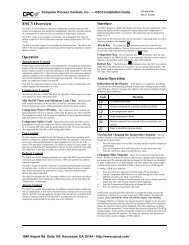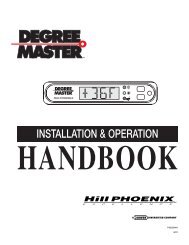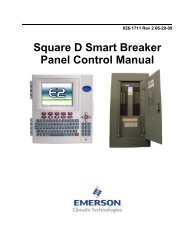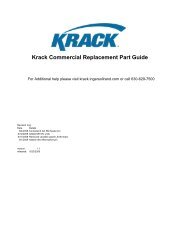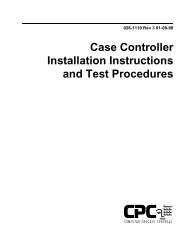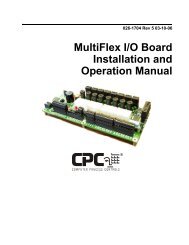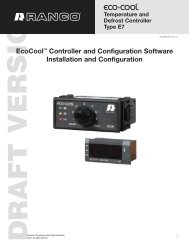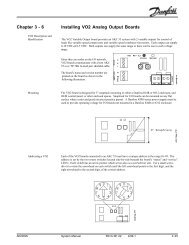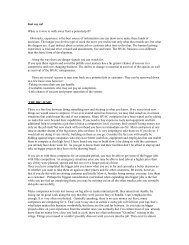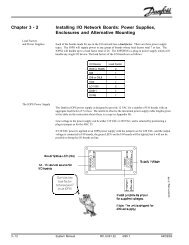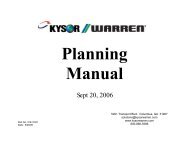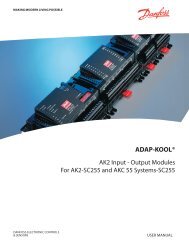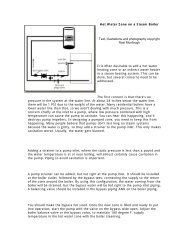Oil Safety Controls - icemeister.net
Oil Safety Controls - icemeister.net
Oil Safety Controls - icemeister.net
Create successful ePaper yourself
Turn your PDF publications into a flip-book with our unique Google optimized e-Paper software.
<strong>Oil</strong> <strong>Safety</strong> <strong>Controls</strong>byTerry Warner<strong>Oil</strong> Pressure Safeties<strong>Oil</strong> <strong>Safety</strong> <strong>Controls</strong> are probably one of the more toughercontrols to get a handle on.For years if I found an oil safety that was bad I wouldreplace it "wire for wire" and go on to the next call.It was some years later that I finally decided to solve themystery of how this control works. This article will show you how to troubleshoot the oil safety and give you an in depth knowledge of its operation.Ready? Let's Go.<strong>Oil</strong> <strong>Safety</strong> ComponentsVoltage Dropping Resistor - This is the big resistor that is readilyvisible when the cover of the control is off. It is usually rectangular orround in shape. Its purpose is to let the control operate on 120 VAC or208/240 VAC.Manual Reset Button - This is usually a button on the front of thecontrol you push to reset the control to its operating position. Sometimesthe button is in the shape of a stem coming out of the top of the control.Pump or <strong>Oil</strong> - This will be a capillary with a 1/4" flare nuton the end. It should fasten to the discharge side of the oil pump.
Suction - This will be a capillary with a 1/4" flare nut on it andwill fasten to someplace where the suction pressure can be measured. Be surenot to fasten the capillary upstream of any valves such as a CPR (Crankcasepressure regulating valve)Time Delay Heater - This heater is internal and is not visible. Thepurpose of this heater is to de-energize the control circuit if the oilpressure becomes too low. It takes the heater approximately 120 to 180seconds to open the control circuit.240 Terminal - This would be one side of your power supply when thecompressor is running. You do not want this voltage present when thecompressor is off because in 120 to 180 seconds the control would open andde-energize the control circuit.L Terminal - This is the other side of your power supply. Again you donot want voltage to this terminal if the compressor is off for the samereason just stated above.120 Terminal - This terminal would be used if your supply voltage was 120VAC and not 208/240 VAC.S Terminal - This is the "alarm" terminal. You can turn on alight or sound a bell or whistle to be alerted that the oil control hastripped.M - This terminal is used for opening the control circuit in case of oilfailure. It is one side of your control circuit.2 - This terminal is usually jumpered to Terminal "M". It isnecessary to be connected to "M" Terminal so the control has acomplete electrical circuit internally.
PurposeIf the compressor oil pressure drops below a set level,usually 10 lbs., the oil failure control will energize a heater that will causethe control to open the compressor contactor and shut the compressor off.(Usually 120 seconds to 180 seconds.)If the compressor oil pressure drops below the set level butrises before the 2 minutes then the heater is de-energized and the compressor isallowed to operate normally.Testing
The easiest way to test the oil control is to take 2 of the 3wires off of the compressor and isolate them. Turn the power back on and timehow long before the oil safety opens up. (usually 2 minutes) I live in anorthern area and if you leave the oil failure control cover off and the wind isblowing it will prevent the heater from getting hot enough to trip the control.(If the electrical circuit is coming off of the compressor terminals you willhave to leave the wires connected together but not connected to the compressorto check the oil safety.) (See drawing below.)Did it trip?Yes. Then the oil control is working correctly.No. Then take a quick look at the control. Did someone snipthe heater wire and the heater can't warm up? (The voltage dropping resistorthat is readily visible.)Heater wire is O.K. Then ohm out the resister. Is it open? Ifit is then the control needs to be replaced. Both check O.K. then it is time todo some more testing.
Determining <strong>Oil</strong> PressureCheck to see if you have good oil pressure. Hook one line tothe suction valve to the compressor. Hook another line to the oil dischargepump.If your oil pressure is 70 psi.If your suction pressure is 30 psi.Then your "Net <strong>Oil</strong> Pressure" would be 40 psi.Or in formula talk, Discharge <strong>Oil</strong> pressure - Suction Pressure= Net <strong>Oil</strong> PressureReplacing the controlUsually the best way is to replace the control is "wirefor wire" if you can. However, if you have been in the field very long youwill find that the "older" experienced technicians used all blackwires, mounted the control down low with the wires away from you and they areold and crack when you try and work with them. Oh Yeah, I forgot to mention thatit is in the dimly lit corner of the compressor room, zero degrees outside witha 40 mph wind, and the ice cream case is around 45 degrees and you are startingto consider getting your resume' in order and find a "real job."(Sorry, I digressed.)In this case install a new <strong>Oil</strong> Control and use 4 wiresinstead of 3. Here's how.From the compressor terminal, T1, run a wire to the"240" Terminal on the control.
From the compressor terminal, T2, run a wire to the"2" Terminal on the control.Remove the jumper from "M" to "2".Here is what you are doing. "240" and "2"are being supplied power when the compressor is running. "L" and"M" become your control circuit and should be wired in series withyour compressor contactor.Sequence of Operation4 Wire Method1. The compressor contactor is energized by the control circuit through"L" and "M".2. The compressor starts and when it does voltage is supplied to terminals"240" and "2".3. If <strong>net</strong> oil pressure exceeds the control settings, usually 10 p.s.i., theswitch contacts "C" and "D" will open and the compressorwill continue to run.4. If the <strong>net</strong> oil pressure is below the control settings, usually 10 p.s.i.,the "C" and "D" contacts will close and energize the timedelay heater. After 120 to 180 seconds the heater will "trip"and contacts "L" and "M" will open and the compressor will
shut off. The "button" or "control" will have to be manuallyreset before operation can resume.Here is what you are doing. If the compressor is running youwill be supplying voltage from T1 and T2 to the oil control to terminals"240" and "2". If the oil pressure is O.K. then the heaterwill not heat and the unit will cycle correctly.If the compressor is running and the oil pressure is low thenyou are supplying 240 volts to the oil control and will energize the heater andopen the contacts "L" to "M". (If you are in a dimly litcompressor room, wire it up with the 4 wire method and then return the nextmorning and look everything over and dress up your wiring.Also, a lot of technicians come off of the compressorterminals for convenience and not the terminals of the contactor. Remember tocome off of the "Load" side of the contactor. You don't want voltageto the oil control if the compressor isn't running.WiringMost units will be wired using the 3 wire method. Below is a wiring diagramshowing both methods.1. "240" - Power supplied to the oil control.2. "L" - Control circuit coming in.3. "M" - Control circuit going out.
4. "2" - Should be jumpered to "M" terminal.The operation is the same. If the oil pressure is low a heater will beenergized and cause the control to open the contacts between "L" and"M".
General Discussion<strong>Oil</strong> Safeties can trip for a multitude of reasons. Usually by thetime you arrive the customer has reset the control several times and the unit isrunning. You are then left with the task of troubleshooting the problem while itis operating.Here are some things to check.1. <strong>Oil</strong> level - The oil level should be around 1/3 of the glasswhen it is running. Never add oil if you don't know where the oil is. In otherwords, if you have a broken line, and oil is all over the floor, then you mayrepair the line and add oil. If oil is not visible then do not add oil.The oil is in the system and you need to determine where. Oneway is to cycle the unit into a defrost and warm the evaporator coil up. Whenthe unit comes out of defrost the oil should return to the compressor.2. Check your oil pressure - You can't troubleshoot a bad oilsafety if your oil pressure is low.3. Check other compressors - On rack systems one compressor canbe worn and pumping oil and it will run the good compressor out of oil and causeit to trip.4. Burnt contacts on the compressor contactor - On occasions thecontacts will not close well enough to start the compressor and after 2 minutesof the compressor contactor being closed and no oil pressure will trip the oilsafety. Then the service tech comes along and resets the oil safety and thecompressor takes off and everything checks out okay.
Hope this helps some of you out.Comments and "smart remarks" are welcomed.You may print or copy this article for your own use. TerryWarner retains all rights. If you would like to publish this article for a newsletter or group publication please write me for permission.I have done my best to make this article error free. I am notresponsible if something burns up or you get electrocuted or you ruin acompressor.Terry Warner



